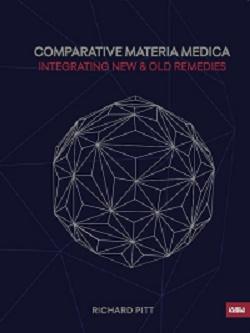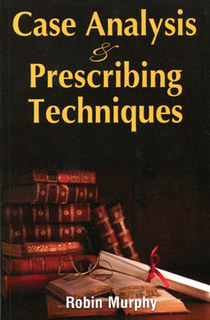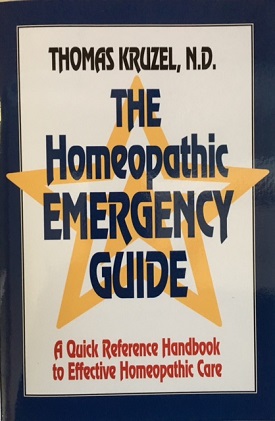Comparative Materica Medica: Integrating New & Old Remedies by RICHARD PITT, RSHom [#PITCOM]
$60.00
Description
Comparative Materica Medica: Integrating New & Old Remedies
By Richard Pitt
This book offers an original perspective on comparative materia medica, incorporating information on newer and less understood remedies within the framework of well-known remedies. It clarifies and systematizes our study of materia medica, allowing us to navigate the complexities of materia medica study more effectively.
There are thirty-six chapters, each one focusing on a well-known remedy, giving an initial summary and utilizing a three-stage development for each remedy – Intrinsic, Compensated, Decompensated – that relates to the three fundamental miasms of Psora, Sycosis and Syphilis. Each remedy is compared and discussed within this framework, weaving comparisons with many other remedies in the process.
Understanding how to relate and compare remedies is essential in the development of homeopathic knowledge and this book explores comparisons and relationships from many perspectives – constitutional, mental, pathological, miasmatic, keynote, organ affinity etc.
There are discussions of remedies from all realms: animals such as insects, birds, mammals and sea remedies; common and unusual mineral and metal remedies and plant and other vegetable remedies, including fungi. Remedies from the bacteria and virus families and other imponderabilia are compared, always looking at possible connections to well-proven and documented remedies.
A Comparative Materia Medica offers a bridge; it allows for the exploration of new areas of homeopathic knowledge, and seeks to ground our existing knowledge into a coherent pattern so the practice of homeopathy can be objectively applied and verified.
PREFACE
The goal of this book is to help students and practitioners with their study of materia medica and cases. One important way of doing this is to study the comparisons between remedies, to explore the similarities and differences that allow us to make the finer distinctions in our prescribing. This book is therefore written from the point of view of the relationship between remedies and not so much the unique image of each remedy. It does not attempt to give an exhaustive picture of remedy pictures but to function as a supplement to the more in-depth materia medicas already available. Therefore, its main goal is to complement other textbooks on the subject and to attempt to weave a holistic view of our materia medica. There is no need to repeat information regarding the groupings of remedies and other methods of comparison that have been explored in detail in other books. However the interconnections between remedies can be seen from many angles and this book hopefully explores some of these in an interesting way.
This book is not adhering to any one methodology of system thinking or theory, whether kingdom, miasm, botanical classification, periodic table etc. Sometimes, classifications are used e.g., botanical families as a means of ordering remedies and/or mnemonic purposes. Of course some classifications are more clinically appropriate for comparison than others. The focus is whether it is clinically relevant and practical as a tool of comparison. Any theory or model is only useful if it makes our job easier and more practical and serves to clarify. The proof of any theory is in its application.
The book is designed to reflect the process of learning materia medica, moving from the larger, more well-known remedies to lesser used remedies, without ideally over-focusing on any one group. I have also listed certain rubrics for each remedy to allow people to study the rubrics and remedies further. The rubrics chosen either reflect key aspects of a remedy or that are not found easily in the repertory. I have not listed many obvious rubrics and I have not listed all the remedies in certain rubrics. The information already exists in the repertory and materia medicas but it is important to understand the relationship between the language of the repertory with the overall picture of a remedy and how that may be revealed in a homeopathic case. A rubric is simply a specific extraction of a symptom that is given as part of a whole story. The goal is to understand the rubric in relation to the whole case and also to be familiar with important rubrics for each remedy as well as to point out important rubrics used in daily practice.
The choice of remedies for each chapter may seem random but they were chosen to reflect their importance in daily prescribing and their function as a useful comparative device for many other remedies. The attempt was to create a representative group of remedies from the many possibilities within our materia medica. Of course, different homeopaths would choose different remedies based on their own experience but hopefully in the end, enough remedies are covered to allow a broad study of most important remedies.
An attempt has been made to balance the information given in each remedy, from the constitutional, psycho-dynamic images of remedies to specific keynotes and objective information that has been well verified in clinical practice. I have tried to avoid certain presumptive descriptions of remedy personality types unless they have been well documented. I have also avoided mentioning remedies whose provings or clinical data are still rather subjective. We have many remedies already and although there are some fascinating new and unusual remedies, I prefer to restrict the references to those remedies with which I’ve had experience or that have some solid documentation behind them. Again, this is a somewhat subjective choice but hopefully a balance is achieved between the better-known and the lesser-known remedies.
There has been a number of comparative materia medica books published before, from Farrington’s classic text in the 19th century to more recent additions. Hopefully this book will complement these and add a modern interpretation to the relationship between homeopathic remedies.
Table of Contents
Each chapter is used as a comparative device to explore the themes of a major remedy and at the same time to discuss the clinical relationships with many other remedies. Each remedy chosen represents certain essential features in our materia medica and has been chosen to act as a useful form of comparison with other remedies. Please see CHAPTER THEMES for more detailed comparison.
The last chapter, Zingiber is so titled as it covers many remedies, e.g., bowel nosodes, sarcodes, imponderabilia etc., that don’t fit into any other chapter and needed another chapter to belong to. The choice of the remedy Zingiber is rather incidental. I like ginger, a ubiquitous food, and many people don’t know it as a homeopathic remedy and so it seemed a good remedy to use as part of the exploration of smaller remedies in the book.
There are three detailed indexes in the book. The first is a simple remedy index, indicating exactly which page(s) a remedy is discussed. When in bold type, the number relates to where the remedy is mentioned in detail. When the remedy is in bold type, it indicates the fact that the remedy is a chapter heading. The second index is the CHAPTER THEMES index and shows the breakdown of each remedy into particular themes and the remedies that are mostly compared under each theme. The third index is a therapeutic repertory index that lists major symptoms and themes in a repertory structure, but where the numbers listed relate to the chapter in which it is found, not the page. All the indexes are designed to be used together for cross referencing as well as finding one’s way through the book.
Chapter 1 Aconite 1
Chapter 2 Agaricus 9
Chapter 3 Apis 21
Chapter 4 Argentum nitricum 35
Chapter 5 Arnica 47
Chapter 6 Arsenicum album 57
Chapter 7 Aurum metallicum 67
Chapter 8 Baryta carbonica 81
Chapter 9 Calcarea carbonica 89
Chapter 10 Carcinosin 109
Chapter 11 Causticum 119
Chapter 12 Ferrum metallicum 127
Chapter 13 Graphites 135
Chapter 14 Ignatia 145
Chapter 15 Kali carbonicum 153
Chapter 16 Lac caninum 167
Chapter 17 Lachesis 181
Chapter 18 Lycopodium 197
Chapter 19 Medorrhinum 205
Chapter 20 Mercurius solubulis 215
Chapter 21 Natrum muriaticum 229
Chapter 22 Nux vomica 247
Chapter 23 Opium 259
Chapter 24 Phosphorus 271
Chapter 25 Platinum 291
Chapter 26 Psorinum 307
Chapter 27 Pulsatilla 315
Chapter 28 Sepia 327
Chapter 29 Silicea 349
Chapter 30 Staphysagria 359
Chapter 31 Stramonium 367
Chapter 32 Sulphur 370
Chapter 33 Tarentula hispanica 391
Chapter 34 Thuja 405
Chapter 35 Tuberculinum 419
Chapter 36 Zingiber 433
Index 1 Remedy Listing 471
Index 2 Chapter Themes 477
Index 3 Therapeutic Themes 507
Paperback, 527 pages
ISBN 978-0-976091-81-3






Reviews
There are no reviews yet.